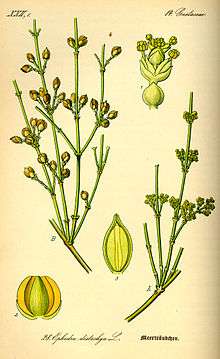Ephedra distachya
Ephedra distachya is a shrub in the family Ephedraceae that stands about 25 cm to 50 cm high. The shrub grows in many parts of the world, including southern and central Europe and western and central Asia.[2][3] Its local names include somlatha.
- Subspecies
- Ephedra distachya subsp. distachya – central + southern Europe, southwestern + central Asia
- Ephedra distachya subsp. helvetica (C.A.Mey.) Asch. & Graebn. – Switzerland, France, Italy, Slovenia, Austria
| Ephedra distachya | |
|---|---|
_2011_1.jpg) | |
| Scientific classification | |
| Kingdom: | Plantae |
| Clade: | Tracheophytes |
| Division: | Gnetophyta |
| Class: | Gnetopsida |
| Order: | Ephedrales |
| Family: | Ephedraceae |
| Genus: | Ephedra |
| Species: | E. distachya |
| Binomial name | |
| Ephedra distachya | |
| Synonyms[2] | |
| |
Uses
Ephedra distachya is used to relieve acute muscular and rheumatic pains (when it is called teamsters' tea), as a stimulant, and in the cardio tonics in Ayurveda. It is sometimes identified with the legendary drug soma, as described in the Avesta and the Rig Veda, the respective ancient sacred texts of the Zoroastrian and Hindu faiths.
Ephedrine, an alkaloid, is obtained from its dried branches and is used as a stimulant, often to control asthma. It was isolated from the plant by Nagayoshi Nagai in 1885. All parts of the plant contain up to 3% ephedrine.[4]
Gallery
 Botanical illustration.
Botanical illustration..jpg) Male plant in bloom.
Male plant in bloom._2.jpg) Pollen cones.
Pollen cones..jpg) Female cones.
Female cones._2011_3.jpg) Ripe cones with seeds.
Ripe cones with seeds. Female plant with ripe cones.
Female plant with ripe cones._2011_1.jpg) Rhizome and bark.
Rhizome and bark.
References
- "Ephedra distachya". Germplasm Resources Information Network (GRIN). Agricultural Research Service (ARS), United States Department of Agriculture (USDA). Retrieved 2008-04-18.
- Kew World Checklist of Selected Plant Families
- Altervista Flora Italiana, Efedra distachia, Ephedra distachya L.
- "Meerträubel (Ephedra distachya) im GIFTPFLANZEN.COMpendium - www.giftpflanzen.com". www.giftpflanzen.com. Retrieved 2008-04-18.
| Wikimedia Commons has media related to Ephedra distachya. |
